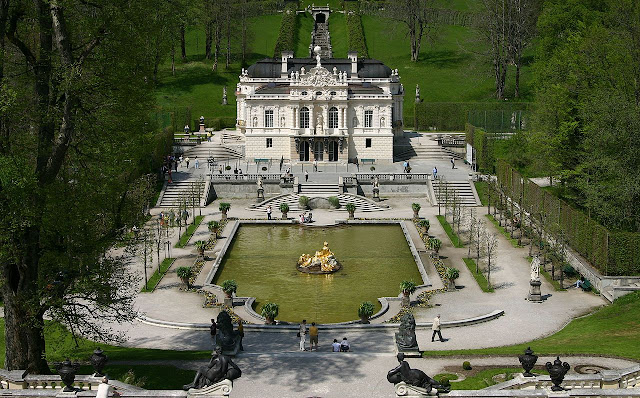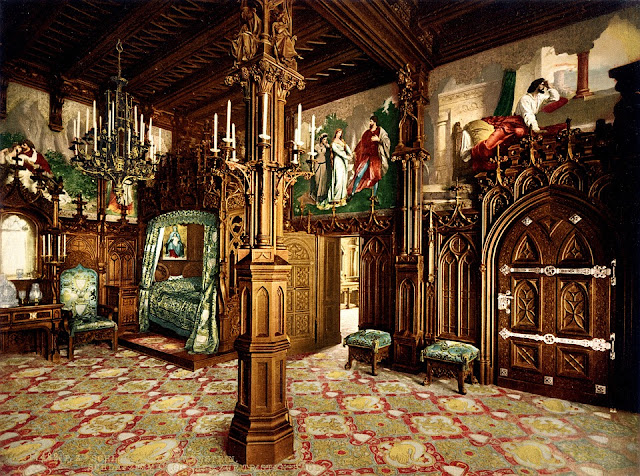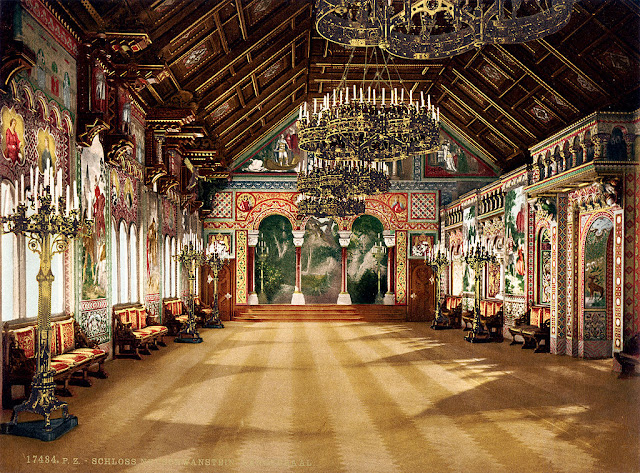The Three Palaces of Ludwig II of Bavaria
Ludwig II built three lavish castles to realize his dreams in brick and stone. He wanted to create palaces that captured the romance of Teutonic Sagas and the splendor of Versailles. Wagner’s operas allowed Ludwig II to enter into the romantic world of Medieval heroes but this experience was limited to the stage. In the castle’s Ludwig II built, Linderhof, Herrenchiemsee, and Neuschwanstein, he could actively enter the golden splendor and romantic tales of times gone by leaving reality far behind.
Linderhof Palace
 |
| Linderhof Palace |
Linderhof was the smallest of the three palaces built between 1863 and 1886, by Ludwig II and was the only palace that he saw completed. It is built in the 18th century Rococo style and is reminiscent of the Petit Trianon in Versailles. The staircase is a smaller recreation of the famous Ambassador’s staircase in Versailles as is Ludwig II’s Hall of Mirrors. Ludwig II idolized the French Sun King, Louis XIV who was the type of absolute monarch that Ludwig II could only dream of being.
Herrenchiemsee or New Palace
 |
| New Palace |
In 1878, Ludwig commissioned a neo-Baroque New Palace to be built as a homage to King Louis XIV and his belief in the divine right of kings on Lake Chiemsee’s idyllic Herrenchiemsee Island. This vast palace was based on a model of Versailles and was built as Ludwig II’s private residence. Like Versailles, it has a Hall of Peace, a Hall of War, and a Hall of Mirrors with a tableau showing Louis XIV at his best. This palace was Ludwig II’s last and largest building project. It remained unfinished at the time of his death with 50 of its 70 rooms still incomplete. After Ludwig II’s death, all work stopped on here. The expenses, in excess of $250,000 in today’s figures brought royal finances to the verge of bankruptcy. Several weeks after Ludwig II’s death this palace was opened to the public. It was given to the State of Bavaria in 1923. Today this palace is still very remote and can only be reached by boat.
Neuschwanstein Castle
 |
| Neuschwanstein Castle |
Neuschwanstein Castle built in the Romanesque Revival style was commissioned by Ludwig II in 1868 as his personal home and retreat in honor of Richard Wagner. The king saw this palace as a romantic interpretation of the Middle Ages and the operas, Tannhauser, Lohengrin, and Parsifal composed by his friend Wagner. Typical of 19th-century architecture this palace mingles Gothic, Romanesque, and Byzantine architectural and artistic styles. Ludwig II concerned himself with the most minute details of the interior design of this castle from the murals and furniture to the chandeliers and dishes. This castle was decorated as a theatrical stage set for Ludwig II to live out his dreams.
 |
| Bedroom of Ludwig II |
In the castle itself, Wagnerian themes dominated the decorations that matched Ludwig’s favorite scenes in Wagener’s operas. In the dining room, murals show scenes from the Wartburg Singers’ Festival. The King’s bedroom has a magnificently carved walnut bed with scenes representing the doomed love affair of Tristan and Isolde from Wagner’s opera set against richly carved oak walls. The King’s study showcases the story of Tannhauser, another opera composed by Wagner. Throughout the castle were reminders of Ludwig’s hero, Lohengrin, and his swans painted on walls, carved into ceilings and arches, cast in porcelain, and woven into exquisite tapestries.
 |
| Ludwig’s Study |
Beyond his bedroom, Ludwig constructed an artificial grotto lined with plaster stalactites, a fountain, and a clockwork moon. And, beyond this room was a hanging winter garden overlooking the Fussen plain below.
 |
| Singer’s Hall |
Above Ludwig’s third-floor bedroom was Ludwig’s singer’s hall modeled on the Wartburg Room where Wagner had set his famous song contest in Tannhauser. This room is bright with its high arched windows letting in the sunny alpine light. The high vaulted ceiling is richly painted in medieval style floral designs and the murals in the room depict the legend of Tannhauser and Parsifal, as well as the saga of the Holy Grail. It is in this room that you will find Ludwig II’s coat of arms, it is the only reference to the creator of this glorious mountaintop castle.
 |
| Throne Room |
The real centerpiece of this castle is the throne room as it was designed as an architectural celebration of the divine right of kings. The style of this room is Byzantine and takes its inspiration from St. Sophia in Istanbul. More than two million tiles compose the intricate floor that depicts animals in the forest. The columns are painted to look like lapis lazuli and porphyry and have gilded Corinthian capitals. At the time of Ludwig II’s death, this palace was far from complete. Ludwig only lived 172 days in the castle and slept in it only 11 nights.

